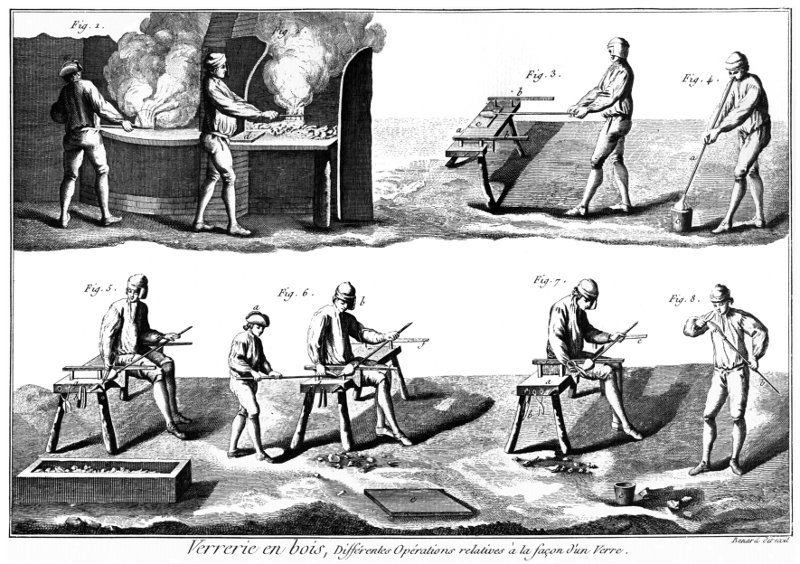- a, maître tiseur remuant la composition avec le pilot
dans le pot de fonte.
- a, maître qui cueille la matiere avec sa canne,
laquelle cueillie se nomme poste. b, joues pour garantir
de la chaleur de l'ouvrau. c, ouvrau ou trou par lequel on
fait les cueillies. d, marbre. e, table de l'ouvrau.
- Ouvrier roulant la poste ou cueillie sur le marbre pour l'unir.
a, banc. b b, bardelle. c, marbre.
- Ouvrier soufflant la poste ou cueillie dans le moule pour la
façonner. a, canne. b, poste dans le moule.
c, moule.
- Maître formant la pointe du calice du verre, &
en coupant un petit bouton rond de ladite pointe pour y placer
le bouton. a, banc. b, pinces & ciseaux
accrochés au banc. c, cire attachée au
banc pour rafraichir la pointe. d, canne. e,
auge à recoupes.
- a, petit garçon tenant la canne où est le
bouton du verre & la présentant au maître.
b, maître prenant la canne du petit garçon
avec sa pince, & l'adaptant au calice du verre. c,
bouton s'attachant au calice du verre. d, ciseau &
pince accrochés au banc pour le travail. e,
marbre posé à terre pour rouler le verre. f f,
bardelle pour rouler la canne.
- Maître donnant la forme au bouton avec sa pince. a,
banc. b, ciseau & pince accrochés au banc.
c c, bardelle.
- Ouvrier formant la patte du verre prête à être
adaptée au bouton. a, partie formant la patte du verre.
b, canne. c, moule.
|
- a, furnace-master stirring the batch (raw materials)
in the melting pot with a pilot (stirring tool).
- a, worker gathering a gob of molten glass from the
pot with his canne (blowpipe).
b, joues (small clay wall blocking heat
from an ouvrau).
c, ouvrau (hole to access pot).
d, marver (iron or marble slab for rolling
and forming the piece).
e, ouvrau's table.
- Worker unifying and shaping the glass on the marver.
a, bench.
b b, bardelle (parallel bars or rails on
the bench for rolling the blowpipe).
c, marver.
- Worker blowing the glass in a mold.
a, blowpipe.
b, glass in mold.
c, mold.
- Gaffer (master) forming a small round button at the base of the
goblet for attaching the stem.
a, bench.
b, jack (tongs/tweezers) & scissors
hanging on the bench.
c, wax attached to the bench for cooling tools.
d, blowpipe.
e, trough for glass fragments.
- a, boy presenting blowpipe with button of glass to the gaffer.
b, gaffer taking the blowpipe & and applying the button
to the goblet, forming the stem.
c, stem attached to the goblet.
d, jack & tweezers hanging on the bench.
e, marver (on the ground) for rolling the glass.
f f, bardelle.
- Gaffer shaping the stem with his jack.
a, bench.
b, jack & scissors hanging on the bench.
c c, bardelle.
- Worker forming the foot to be attached to the stem.
a, gob for foot.
b, blowpipe.
c, mold.
|
